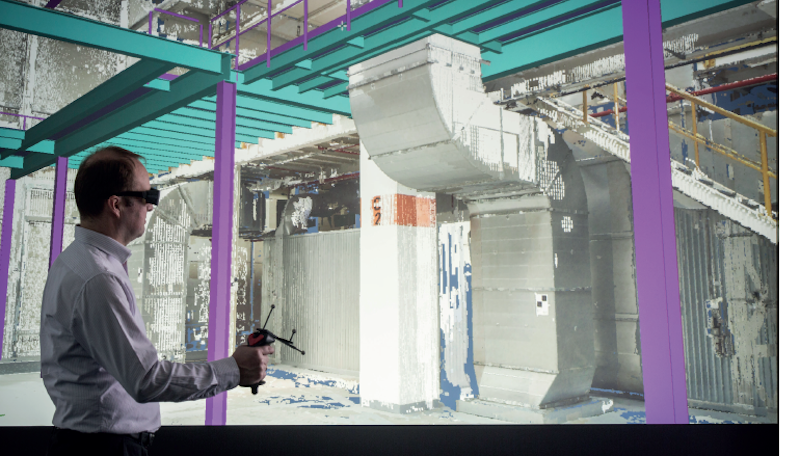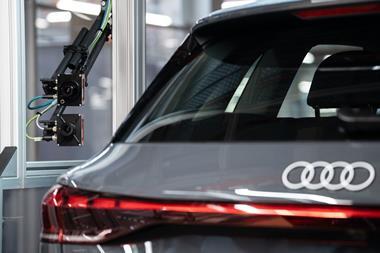
Dürr is using laser scanning and virtual paintshops to plan and perfect its real-world modernisation and expansion projects
 Laser scanning is the most modern measurement method for buildings. When the scan data is combined with the plant plans in 3D, virtual models reveal potential issues to address and solutions to apply. Translated to reality, this means shorter installation times, reduced conversion costs, and smooth processes.
Laser scanning is the most modern measurement method for buildings. When the scan data is combined with the plant plans in 3D, virtual models reveal potential issues to address and solutions to apply. Translated to reality, this means shorter installation times, reduced conversion costs, and smooth processes.
Laser scanning has revolutionised property surveying. The laser beam records all relevant features like parapet heights, doors, or cable ducts as well as existing production facilities. This is possible even in hard-to-access areas, in a non-contact measurement and from distances of up to 130m. Software generates real, detailed images from the data. “When working on brownfield projects, we are frequently confronted with the situation where there is either no documentation any more for factories and the sections they contain, or just analogue original plans that have never been updated,” says Marc Altmann from the engineering department at Dürr.
Laser scans bring the real world to the screen digitally, and thus provide the perfect basis for planning. For large industrial buildings, the data consist of hundreds of individual scans that are precisely matched using reference points. They provide a way of reviewing whether a customer’s vision is compatible with the structural conditions and the engineering of a painting line or final assembly line – namely at a very early stage. Dürr uses the method as early as during the tendering phase.

Virtual visitSpecial computer technology processes the large volume of the scanning data and transfers it as photorealistic images or videos to the so-called Powerwall at the Dürr Campus in Bietigheim-Bissingen. “We can take a virtual tour of any building, no matter where it is in the world, together with our customers here in the Powerwall room. This is much more visual than a plan on paper and makes it possible to identify and discuss complications in advance and find a good solution. This means that a paint shop can be executed as planned with a high degree of certainty when it comes to quality, schedule, and costs,” explains Altman.
In the next step of the process, the laser scans bring reality into the engineering department. Regardless of where a site is located, a design engineer can view the realistic image at his or her desk in Bietigheim-Bissingen. The exact scans have an accuracy of +/-2mm.
A conventional measurement using a ruler or manual laser measurement could not reach this level of precision. Forgotten measurements can also be easily added on the screen. “We create 3D CAD models for a project’s entire scope of delivery, and merge them with the laser scans. We therefore integrate our plant virtually on the PC into the reality of the building situation. This lets us see whether collisions might occur, for example due to an air duct in the way of the planned constructional steelwork,” says Altmann.
This method visualises the entire layout of the plant construction like dimensions and interfering edges, as well as areas where space for door openings needs to be included. Each individual part of the plant such as the conveying technology or the plant in entirety with components like spray booths and robots can be visualised.
React and planThe highly precise laser scans also show features that cannot be seen with the naked eye, like small tolerances in the floor. This knowledge enables the design engineer to react in good time and plan filler plates on the machines or specific minimum distances from the outset. It is not always possible to adapt the plant engineering to the building situation. “The laser scans let us see very clearly whether demolition will be necessary, which saves our customers time. This makes conversion work much easier than doing them while installation is underway,” says Altmann.Dürr is now using laser scanning almost as standard in modifications and expansions. In view of the growing requirements and the increasing complexity involved in the construction of paint shops, the innovative measurement method makes a valuable contribution to projects going smoothly on site.
Next-generation production controlDürr’s new Industry 4.0-focussed iTAC.IoT.Suite is a combination of the production-related Manufacturing Execution System (MES) EcoEMOS and the high-performance software solutions from iTAC Software AG, which was acquired at the end of 2015.
iTAC was recently named one of the five leaders in the field of Industry 4.0 platforms by the Experton Group as part of the study Industry 4.0/IoT Benchmark 2017. The acquisition of iTAC was part of the Industry 4.0 strategy digital@DÜRR.
The iTAC.IoT.Suite represents a joint development between Dürr and iTAC based on a modern software architecture which can be adapted to different production control requirements in the automotive, electrical, and component industries (tier 1). With a modular structure, users are able to select individual functions and create a tailored solution for their entire production chain. New functionalities have been added to the proven EcoEMOS modules – eg, SCADA, stock control, vehicle tracking as well as energy and quality management – for controlling automotive production. These includes business intelligence, machine monitoring, and order management. The traceability module also provides add-ons for detailed material tracking. As a state-of-the-art system, the iTAC.IoT.Suite also includes a comprehensive order planning module.
All the functions can be clearly visualised on screens. The iTAC.IoT.Suite also offers a comprehensive analysis of all plant parameters, and therefore forms the basis for future Industry 4.0 applications. An optional cloud connection enables the combination of data from different production facilities across a plant as well as the subsequent evaluation using modern analytical methods like Big Data Analytics. Processes and key performance indicators can thus be tracked in real time. The insights obtained can be used in a targeted manner to optimise the production workflows.
Data acquisition and storage with the iTAC.IoT.Suite guarantees comprehensive traceability of all production processes. The modern software architecture improves production monitoring, efficiency, and quality. To ensure that all data is kept within the company, the iTAC.IoT.Suite offers maximum IT security: Dürr uses software technologies that utilise state of the art cyber security reinforced by regular updates. These work with security measures on the customer side – eg, firewalls and separation of office and production networks – to maximise security. For the customer, the fail-safe system offers a wide range of functions with high scalability. The flexible program structure permits individual combination and fast availability of the functional modules as well as easy software releases.
The iTAC.IoT.Suite opens up a new dimension in the management of plants and production data. The platform forms the backbone for end-to-end networked and digitised processes in production. The Dürr support teams in Bietigheim-Bissingen and other locations will continue to support existing EcoEMOS installations, both around the clock and around the world.





































